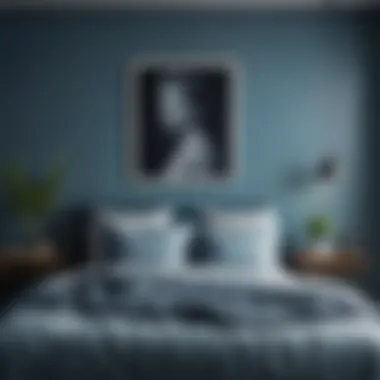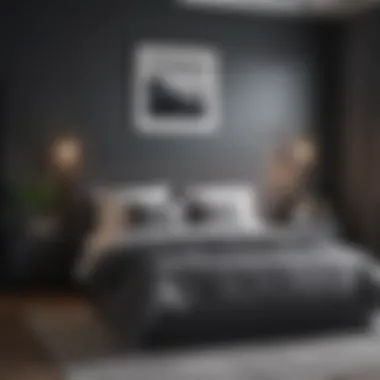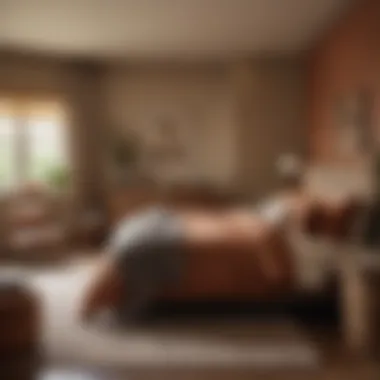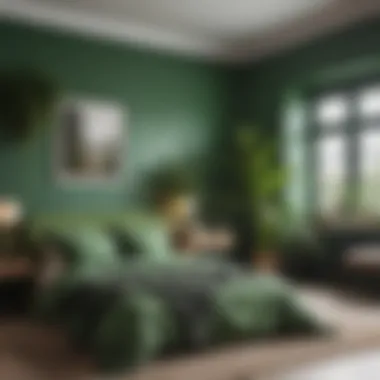Choosing the Perfect Paint Colors for Men's Bedrooms


Intro
Selecting the appropriate paint color for a men's bedroom transcends mere aesthetics; it reflects personal style and influences emotional well-being. Color psychology suggests that hues can evoke specific feelings and moods, thus making the choice of color crucial. The psychological impacts of color can manifest in daily life, affecting relaxation, focus, and motivation. This decision can reshape not only the space but also the atmosphere of the room. For homeowners and renters alike, understanding the interplay between color and emotion lays the groundwork for creating a personally tailored sanctuary.
The journey into choosing the right paint color begins by examining design inspirations and current trends in interior design. This exploration should encompass a variety of palettes tailored for diverse personality types, from minimalist individuals to the more adventurous decorators, ensuring that the final selection truly reflects the owner's identity.
Key points of focus will encompass:
- Psychological effects of colors: Understand how different shades can influence mood.
- Trending shades: Explore what colors are currently in vogue in interior design.
- Personal style reflection: Determine how color can showcase one’s personality.
- Practical considerations: Discuss the functional aspects affecting color choice, such as room size and lighting.
Through this discussion, the article aims to provide actionable insights to empower readers in enhancing their living spaces with the ideal paint color.
Understanding the Importance of Color in a Bedroom
When selecting paint colors for a men's bedroom, it is crucial to comprehend the significance of color in creating an environment that expresses individuality and comfort. Color does not simply serve as background; it interacts with our emotions and can drastically alter the perception of space. Therefore, understanding these dynamics can lead to wiser choices that enhance both aesthetics and functionality in the bedroom.
Psychological Effects of Color
Color possesses the ability to evoke various psychological responses. For instance, blues are often associated with calm and tranquility, making them ideal for restful environments. In contrast, reds and bright oranges can stimulate energy and may not be suitable for sleep areas. Men might find it beneficial to choose shades that encourage relaxation, especially if the bedroom doubles as a personal sanctuary.
Research shows that color can influence our mood and behavior significantly. A soft green, by promoting serenity, might lead to a more restful night. Understanding these effects is critical when aiming to design a harmonious living space.
Color and Personal Identity
Color choices often reflect personal identity and style. Men may gravitate towards certain colors that resonate with their personality. For example, individuals with minimalist tendencies may prefer whites or grays, while those with a bold spirit might choose darker hues.
Your bedroom should tell your story. It acts as both a retreat and a reflection of who you are. Choosing the right paint color is one of the first steps to make this space truly your own.
Influence on Mood and Well-Being
The link between color and well-being is notable. The bedroom's paint color can impact how one feels day-to-day. Warmer tones might evoke feelings of coziness, whereas cooler tones may promote clarity and focus.
A well-thought-out color scheme can contribute to a more positive emotional landscape. Creating a restful environment can lead to better sleep, increased productivity, and overall life satisfaction. Thus, it is essential to consider how different colors align with your mood and well-being.
In summary, understanding the impact of color on our emotions, identity, and overall well-being is a crucial aspect when choosing paint colors for a men’s bedroom. Making informed decisions can transform your space into a true reflection of you.
Trending Colors for Men's Bedrooms
Selecting the right paint color for a men’s bedroom is practical for aesthetics and personal expression. The trending colors available today not only provide beauty but also can enhance the mood of the space. Understanding these trends helps in making informed decisions that reflect personal style and preference. This section will explore various trending colors, emphasizing their unique qualities and the emotional benefits they offer.
Neutral Shades
Neutral shades are often the foundation of contemporary interior design. Colors such as beige, gray, and taupe blend seamlessly with many styles and decorations, making them a practical choice. They provide a harmonious backdrop that can invoke calmness and balance. By using neutral colors, one allows for flexibility in adding accents in other vibrant colors through furniture and decor. This versatility is particularly beneficial for those who prefer to change elements in their space often.
Bold and Dark Hues
Bold and dark hues are gaining popularity for those wanting a dramatic effect in their bedrooms. Deep navy, charcoal black, or rich burgundy can easily provide a sense of sophistication. These colors create an intimate atmosphere, making the bedroom feel like a true retreat. However, it is important to balance these dark tones with adequate lighting and carefully selected pieces of decor. Pairing dark walls with lighter furnishings can help avoid a heavy feeling in the room.
Earthy Tones
Earthy tones such as olive green, terracotta, and muted browns offer a connection to nature. These colors can bring warmth and comfort to a bedroom, appealing to those who appreciate an organic feel in their environment. Earthy tones are calming and can encourage relaxation, which is essential in a space meant for rest. They also encourage a seamless blend with indoor plants and wooden furniture, further enhancing the natural atmosphere of the room.
Accent Colors


Accent colors serve as a great way to add personality without overwhelming the space. This could include brighter hues like mustard yellow or teal that pop against neutral backgrounds. Accent walls or decorative items painted in these colors can highlight specific areas of the room while maintaining visual balance. It's crucial to choose accent shades that resonate personally, as they contribute to defining individual style and preference within the bedroom's design.
These trending colors can transform a men’s bedroom into a reflection of individuality and style. Incorporating them thoughtfully will lead to a space that is not only visually appealing but also emotionally uplifting.
Choosing the Right Color Based on Personality
Choosing the right paint color is not just about aesthetics. It reflects one’s identity and influences the atmosphere of the bedroom. Every personality has unique traits that can be represented by different color choices. By understanding how personality shapes these preferences, homeowners can create a space that feels both comfortable and authentic.
A well-chosen color can enhance mood, promote relaxation, and even boost productivity. This section explores selections based on three specific personality types: the Minimalist, the Adventurous, and the Traditionalist. Each type has distinct characteristics that influence their ideal color palette.
For the Minimalist
Minimalism is about simplicity and functionality. Individuals who identify with this lifestyle often prefer clean lines and uncluttered spaces. Therefore, their choice of paint color is typically muted and subtle. Neutral colors such as white, gray, and beige form a foundational palette. These tones create an airy feel, making the room seem larger and more open.
- Benefits of Neutral Colors:
- Provide a calm environment.
- Serve as a blank canvas for decor.
- Allow flexibility with furnishings and accessories.
When selecting a color, consider soft shades that evoke tranquility. Light taupe or sage green can add warmth without overwhelming the senses. Additionally, incorporating textures will enrich the space while maintaining minimalist principles. Using large, soft textiles for bedding can break monotony without complicating the overall aesthetic.
For the Adventurous
Adventurous personalities thrive on excitement and spontaneity. Their paint color choices often reflect boldness and creativity. Rich, vibrant colors like deep blues, fiery reds, or lush greens can energize the space. These hues inspire vitality and can stimulate creativity, perfect for those seeking an invigorating atmosphere.
- Vibrant Color Options:
- Royal Blue: adds depth and a sense of serenity.
- Cardinal Red: promotes passion and energy.
- Emerald Green: offers a fresh, dynamic vibe.
When opting for adventurous colors, consider utilizing an accent wall. Painting one wall a bold hue adds visual interest without overwhelming the room. Pair these striking colors with eclectic decor items that showcase personal stories or travels, creating a narrative within the space.
For the Traditionalist
Traditionalists appreciate heritage and timeless elegance. Their preferred colors are usually classic and understated, such as navy blue, forest green, or burgundy. These deep, rich tones evoke a sense of warmth and formality, providing a sophisticated backdrop.
- Key Colors to Consider:
- Navy Blue: conveys sophistication and reliability.
- Forest Green: offers a connection to nature and tradition.
- Burgundy: adds richness and warmth.
In a traditional bedroom, consider combining these colors with antique furnishings or classic decor elements. This cohesive style enhances the overall ambiance while reflecting the homeowner's respect for history and design. Proper integration of shades can make a space feel inviting yet dignified.
"Color isn’t merely a visual experience; it is a gateway to expressing individuality."
Ultimately, aligning paint colors with personality traits can transform a bedroom into a sanctuary. Each choice conveys a unique story, thereby enhancing one’s living space and personal experience.
Practical Considerations in Choosing Paint Colors
When selecting paint colors for a men’s bedroom, various practical considerations significantly influence the outcome. These elements shape not only the aesthetic but also how the space feels and functions. It’s vital to assess these factors to make informed decisions that lead to a satisfying result.
Room Size and Proportion
The dimensions of the room play a crucial role in color choice. Smaller rooms can appear more cramped with dark colors, whereas lighter tones give an illusion of expansiveness. If the aim is to create a sense of openness, consider soft whites or light grays. Conversely, larger rooms allow for bold colors. A rich navy or forest green can provide warmth and intimacy, making spacious areas feel more inviting.
Tips for different room sizes:
- Small Rooms: Use pastel shades or light neutrals to enhance brightness.
- Medium Rooms: A balance between light and dark can create depth.
- Large Rooms: Feel free to experiment with darker hues; they can evoke coziness.


It's wise to measure room proportions. Sometimes, highlighting one wall in a deeper shade while keeping the rest lighter can create a focal point without overwhelming the space.
Natural Light and Its Effect
Natural light significantly alters how colors appear on walls. A room filled with sunlight may accentuate warm tones, while a dimly lit space can make colors seem colder or duller. Mirrors and the room’s orientation towards the sun also affect light conditions, which should be factored into the decision-making process. A color may look different at various times of day.
To test how a color interacts with light:
- Observe it in the morning, afternoon, and evening.
- Pay attention to how shadows and reflections influence the color’s perception.
Choosing colors that respond positively to the room’s natural light can elevate the overall ambiance. For instance, soft greens can feel refreshing in bright light, while blues might appear muted in shade.
Existing Furniture and Decor
The existing furniture and decor must align with the chosen paint color to achieve harmony in the space. A bedroom with modern furniture may lend itself to cooler, minimalist colors like slate gray or muted blue. On the other hand, traditional or vintage pieces may look best paired with warm, rich tones like deep burgundy or olive green.
Considerations for integration:
- Style Cohesion: Ensure the paint complements the decor style, whether contemporary or rustic.
- Color Schemes: Create a palette that works with the furniture hues. Take swatches and see how they look next to your items.
The paint color should neither clash nor compete but work synergistically with the furniture and decor to create a unified look.
In summary, practical considerations such as room size, natural light, and existing furnishings are vital in selecting paint colors for a men’s bedroom. By thoughtfully analyzing these aspects, one can achieve a balanced and visually appealing space suited to their personal style.
How to Sample Paint Colors Effectively
Sampling paint colors is a crucial step when choosing the right hue for a men’s bedroom. This process allows homeowners to visualize how a color will look in their space before committing to a full painting. Effective sampling helps avoid costly mistakes and ensures satisfaction with the final choice. It involves understanding how colors interact with light and existing elements in the room.
Using Paint Swatches
Paint swatches are the simplest way to visualize color options. Swatches come in various sizes and can be found at any hardware or paint store. It is prudent to pick multiple swatches that resonate with your vision.
When selecting paint swatches, consider the following:
- Choose a range of colors: Pick various shades within your desired palette. This helps to gauge how different hues impact the overall look.
- Observe the texture: Pay attention to the finish of the paint, as matte, satin, or gloss can alter the perception of the color.
- View under natural light: Always check the swatches in natural light to ensure colors appear true to their samples.
Testing Paint on Walls
Once you have narrowed down a few colors, the next step is to test them directly on the wall. This paints a more accurate picture of how the color will look in the actual space. Here are some practical steps:
- Apply patches: Paint large patches of the colors you are considering. Smaller samples might not show the full effect of the color.
- Consider the surface: Different wall surfaces can affect how paint looks. Smooth surfaces reflect light differently than textured ones.
- Take your time: Give the paint adequate time to dry. Wet paint can appear darker or glossier.
Evaluating Color at Different Times of Day
Color perception can shift dramatically depending on lighting conditions throughout the day. Therefore, it is essential to evaluate how a paint color looks at different times.
- Morning light: Typically provides a cooler tone, which can make colors appear fresher.
- Afternoon light: Often yields the warmest tones, enhancing warmer colors.
- Evening light: Artificial lighting can significantly change the look of the color. Pay attention to how the hue interacts with lamps and fixtures.
"Informed choices lead to beautiful spaces. Always test and observe colors to find the perfect match."
Sampling paint colors effectively increases the chances of selecting a hue that feels right in a personal space. This approach minimizes the risk of dissatisfaction and supports better decision-making when it comes to home aesthetics.
Maintaining a Balanced Color Palette
The choice of paint color for a men's bedroom is not merely about aesthetics; it is about creating an environment that feels cohesive and harmonious. Maintaining a balanced color palette ensures that the room does not feel disjointed or overwhelming. A well-thought-out color scheme contributes to the overall atmosphere and functionality of the space.


When selecting colors, it is vital to consider how they interact with one another. A balanced palette prevents visual chaos and promotes a sense of calm and order. This is especially important in personal spaces like bedrooms, which serve as retreats from the busyness of daily life.
Complementary Colors
Utilizing complementary colors can enhance the overall look of a bedroom. Complementary colors are those that are opposite each other on the color wheel. For example, choosing blue walls with orange accents can create a visually pleasing tension. This principle can be applied to furnishings, artwork, and decorative elements as well.
Some benefits to using complementary colors include:
- Visual Interest: They draw the eye and create focal points.
- Energetic Balance: The opposition fosters a dynamic yet harmonious energy in the room.
- Flexibility: They can work in various themes, from modern to classic.
However, it is crucial to apply them in moderation. Use vibrant colors for accents only if the base color is more muted, allowing the former to pop without overwhelming the room’s overall feel.
Creating Depth with Shades
Depth adds richness to a bedroom's design. By mixing different shades of a color, it is possible to create a layered effect. For example, a dark navy can be complemented by lighter shades like sky blue or gray. This technique creates a sense of dimension, making the room feel larger and more inviting.
Consider these strategies for creating depth:
- Monochromatic Schemes: Using variations of one color enhances elegance.
- Textural Variation: Combining various materials within the same color family can create an inviting space.
- Strategic Placement: Use darker shades on the walls and lighter shades on the ceiling or trim to visually lower the ceiling height.
It is also important to apply this method with care. Too many shades can complicate the visual narrative and detract from the calming aspects of the space. By marrying depth with harmony, you can achieve a room that feels both stylish and personal.
Finishing Touches After Painting
After completing the painting process, it is crucial to focus on the finishing touches. This stage is where the overall aesthetic of the bedroom can be greatly enhanced. Selecting the right elements and ensuring they complement the chosen paint color can create a harmonious environment. The psychological impact of colors in a space is significant. Thus, every item introduced after painting should contribute to the intended mood.
Selecting Appropriate Furnishings
Furnishings play a key role in defining the character of a bedroom. When choosing them, consider how they interact with the wall color. If dark hues are used, lighter furniture can create a striking contrast that helps prevent the room from feeling too enclosed. For neutral tones, more vivid furnishings can provide interest without overwhelming the space. Here are factors to weigh in making a selection:
- Style: The furnishings should reflect the personal style of the individual. Whether modern, industrial, or traditional, the right style can enhance the overall theme of the room.
- Color Coordination: Consider colors of the furnishings in relation to the paint. This includes shades of fabric, wood finishes, and any metal elements. They should either contrast or complement the wall color.
- Functionality: Select items that are both functional and aesthetically pleasing. A well-crafted desk or chair can add both style and utility.
By thoughtfully selecting furnishings that complement the paint, the bedroom can become a more inviting space that mirrors personal taste.
Incorporating Textures and Layers
To elevate the visual appeal of a painted bedroom, adding textures and layers is essential. This approach adds depth to the decor and enhances comfort. Here are some ideas for incorporating layers:
- Bedding: Rich textiles in bedding can bring warmth and softness to the room. Consider materials like linen or cotton, featuring different textures or patterns that resonate with the wall color.
- Rugs: A well-chosen area rug can anchor the space. If the walls are a solid color, a patterned rug can introduce a fun element without clashing. Alternatively, if the walls are busy, a simple rug can help maintain balance.
- Curtains and Blinds: These can add a finishing touch to windows, providing both functional benefits and aesthetic appeal. Light fabrics can soften the look and allow natural light to filter in, while heavier fabrics can create a cozier environment.
Incorporating textures does not just beautify the space; it also creates an inviting atmosphere that promotes relaxation.
In summary, finishing touches after painting are vital for achieving a unified and attractive space. By carefully selecting furnishings and adding layers of texture, the effectiveness of the paint color can be fully realized, making the bedroom not just a place to sleep, but a reflection of personal style.
Ending: Final Thoughts on Choosing Paint Colors
Choosing the right paint color for a men’s bedroom is not just about aesthetics; it has far reaching implications on mood and personal identity. This final section summarizes key considerations that should guide your decisions. Color can express your style and can significantly impact how you feel in your space. Therefore, understanding the interplay between color and personal preferences is essential in making a choice that resonates with your individuality.
Reflecting Personal Style
Personal style is highly subjective. Every man has distinct tastes, often influenced by hobbies, lifestyle, and overall personality. When selecting a paint color, think about what resonates with you. For some, a sleek gray might evoke sophistication, while for others, a deeper navy may feel more comforting and grounded. To best reflect your style, consider the following:
- Choose colors that resonate with your interests. Are you into sports, music, or perhaps nature? Subtle greens or blues may align with a love for the outdoors, while stark, modern hues might express a preference for minimalism.
- Use accents to express personality. If you prefer bold statements, consider a neutral base with one or two accent walls painted in striking colors like deep red or black.
- Consider the message you send. Certain colors evoke particular feelings and have societal associations. Hence, a color choice could reflect your standing or intentions. Think carefully about how each color speaks to you and to others.
The Long-Term View on Color Choices
When choosing paint colors, think long-term. A well-considered color choice not only beautifies your space but also enhances livability. Paint colors near the entrance for a warm welcome or in the bedroom for relaxation should be selected with longevity in mind. Here are several factors to ponder:
- Durability of style. Trends can come and go. Opt for colors that have staying power for a more timeless look. For instance, classic neutrals tend to age well.
- Impacts on resale value. If you anticipate selling your home, consider how your color choices may affect its marketability. A universally appealing color can enhance a room’s attractiveness to prospective buyers.
- Maintenance and freshness. Lighter colors may require more upkeep, while darker shades may limit the perception of space. Factor in maintenance when making your selections to avoid frequent repainting, which can be time-consuming and costly.
Ultimately, paint color is more than a decorative layer on walls. It is an expression of personal identity, feelings, and lifestyle. Instantly transformational, the right color can create a sanctuary that talks to who you are. As you finalize your color choices, remain mindful of all these elements. They will significantly influence not only your room's aesthetic appeal but also how you engage with that space daily.



